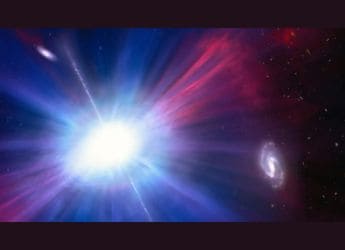- Home
- Science
- Science News
- 'Cloud' Over Mars Leaves Scientists Baffled
'Cloud' Over Mars Leaves Scientists Baffled

Amateur astronomers have spotted two strange, cloud-like plumes high over Mars, deepening the mystery of what constitutes the Red Planet's atmosphere, a study said Monday.
The phenomenon was observed on March 12, 2012 over the "terminator", the boundary between day and night on Mars.
One of the plumes developed in around 10 hours and lasted for about 11 days, shifting shape from "double blob protrusions" to pillars which merged into a "finger", the study authors wrote.
A second was spotted nearby on April 6, 2012, and lasted about 10 days.
Their trails were vast, extending between 500 and 1,000 kilometres (300 to 600 miles) in north-to-south and east-to-west directions.
The "clouds" - if that is indeed what they were - were seen at high altitude, at about 200-250 kilometres, roughly above Terra Cimmeria, which is part of Mars' rugged southern highlands, according to the paper.
Mars is being scrutinised for signs of water and volcanic activity, both of which could theoretically nurture some form of life.
(Also See: Simulated Mars Mission Gutted in Fire)
Clouds of dust or ice crystals have been spotted occasionally over Mars in the past.
But they have never been as extensive as the latest two, and they always formed at an altitude below 100 kilometres.
The plumes could be made of particles of water or carbon dioxide, said the paper published in the journal Nature Geoscience by a team led by Agustin Sanchez-Lavega of the University of the Basque Country in Bilbao, Spain.
Alternatively, it could be an aurora, similar to the shimmering light show that develops in Earth's atmosphere when solar particles collide with Earth's magnetic field.
Past surveillance by scientific orbiters have suggested Terra Cimmeria to have a "strip" with a strong but localised magnetic field.
If correct, the Martian "aurora" would be a remarkable 1,000 times brighter than its terrestrial equivalent.
But "both explanations defy our current understanding of Mars' upper atmosphere," the scientists admit.
Get your daily dose of tech news, reviews, and insights, in under 80 characters on Gadgets 360 Turbo. Connect with fellow tech lovers on our Forum. Follow us on X, Facebook, WhatsApp, Threads and Google News for instant updates. Catch all the action on our YouTube channel.
Related Stories
- Samsung Galaxy Unpacked 2025
- ChatGPT
- Redmi Note 14 Pro+
- iPhone 16
- Apple Vision Pro
- Oneplus 12
- OnePlus Nord CE 3 Lite 5G
- iPhone 13
- Xiaomi 14 Pro
- Oppo Find N3
- Tecno Spark Go (2023)
- Realme V30
- Best Phones Under 25000
- Samsung Galaxy S24 Series
- Cryptocurrency
- iQoo 12
- Samsung Galaxy S24 Ultra
- Giottus
- Samsung Galaxy Z Flip 5
- Apple 'Scary Fast'
- Housefull 5
- GoPro Hero 12 Black Review
- Invincible Season 2
- JioGlass
- HD Ready TV
- Laptop Under 50000
- Smartwatch Under 10000
- Latest Mobile Phones
- Compare Phones
- Honor Win RT
- Honor Win
- Xiaomi 17 Ultra Leica Edition
- Xiaomi 17 Ultra
- Huawei Nova 15
- Huawei Nova 15 Pro
- Huawei Nova 15 Ultra
- OnePlus 15R
- Asus ProArt P16
- MacBook Pro 14-inch (M5, 2025)
- OPPO Pad Air 5
- Huawei MatePad 11.5 (2026)
- Xiaomi Watch 5
- Huawei Watch 10th Anniversary Edition
- Acerpure Nitro Z Series 100-inch QLED TV
- Samsung 43 Inch LED Ultra HD (4K) Smart TV (UA43UE81AFULXL)
- Asus ROG Ally
- Nintendo Switch Lite
- Haier 1.6 Ton 5 Star Inverter Split AC (HSU19G-MZAID5BN-INV)
- Haier 1.6 Ton 5 Star Inverter Split AC (HSU19G-MZAIM5BN-INV)

















